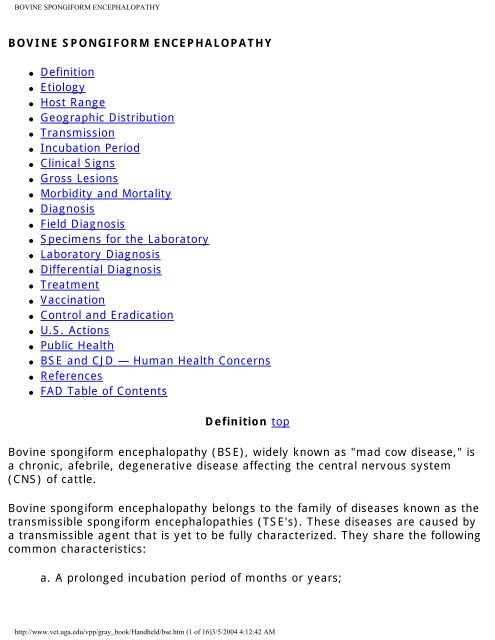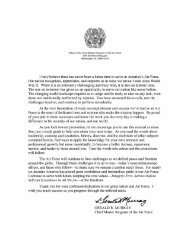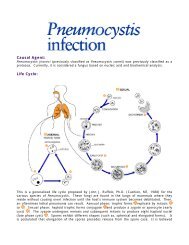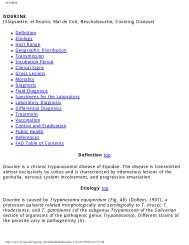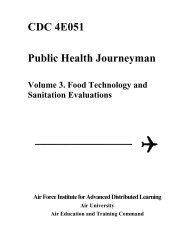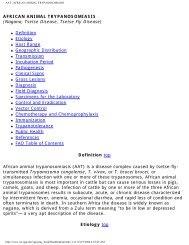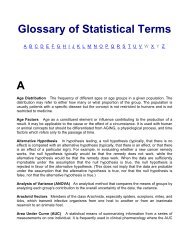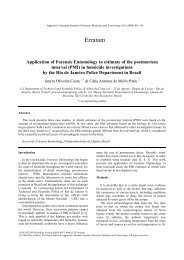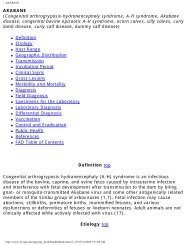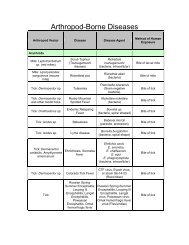bovine spongiform encephalopathy - Public Health Information and ...
bovine spongiform encephalopathy - Public Health Information and ...
bovine spongiform encephalopathy - Public Health Information and ...
Create successful ePaper yourself
Turn your PDF publications into a flip-book with our unique Google optimized e-Paper software.
BOVINE SPONGIFORM ENCEPHALOPATHY<br />
BOVINE SPONGIFORM ENCEPHALOPATHY<br />
●<br />
●<br />
●<br />
●<br />
●<br />
●<br />
●<br />
●<br />
●<br />
●<br />
●<br />
●<br />
●<br />
●<br />
●<br />
●<br />
●<br />
●<br />
●<br />
●<br />
●<br />
●<br />
Definition<br />
Etiology<br />
Host Range<br />
Geographic Distribution<br />
Transmission<br />
Incubation Period<br />
Clinical Signs<br />
Gross Lesions<br />
Morbidity <strong>and</strong> Mortality<br />
Diagnosis<br />
Field Diagnosis<br />
Specimens for the Laboratory<br />
Laboratory Diagnosis<br />
Differential Diagnosis<br />
Treatment<br />
Vaccination<br />
Control <strong>and</strong> Eradication<br />
U.S. Actions<br />
<strong>Public</strong> <strong>Health</strong><br />
BSE <strong>and</strong> CJD — Human <strong>Health</strong> Concerns<br />
References<br />
FAD Table of Contents<br />
Definition top<br />
Bovine <strong>spongiform</strong> <strong>encephalopathy</strong> (BSE), widely known as "mad cow disease," is<br />
a chronic, afebrile, degenerative disease affecting the central nervous system<br />
(CNS) of cattle.<br />
Bovine <strong>spongiform</strong> <strong>encephalopathy</strong> belongs to the family of diseases known as the<br />
transmissible <strong>spongiform</strong> encephalopathies (TSE's). These diseases are caused by<br />
a transmissible agent that is yet to be fully characterized. They share the following<br />
common characteristics:<br />
a. A prolonged incubation period of months or years;<br />
http://www.vet.uga.edu/vpp/gray_book/H<strong>and</strong>held/bse.htm (1 of 16)3/5/2004 4:12:42 AM
BOVINE SPONGIFORM ENCEPHALOPATHY<br />
b. A progressive debilitating neurological illness that is always fatal;<br />
c. When examined by electron microscopy, detergent-treated extracts<br />
of brain tissue from animals or humans affected by these diseases<br />
reveal the presence of scrapie-associated fibrils (SAF's);<br />
d. Pathological changes appear to be confined to the CNS <strong>and</strong> include<br />
vacuolation <strong>and</strong> astrocytosis;<br />
e. The transmissible agent elicits no detectable specific immune<br />
response in the host.<br />
Specific types of TSE's include scrapie, which affects sheep <strong>and</strong> goats;<br />
transmissible mink <strong>encephalopathy</strong>; feline <strong>spongiform</strong> <strong>encephalopathy</strong>; chronic<br />
wasting disease of deer <strong>and</strong> elk; <strong>and</strong> five rare diseases in humans: kuru,<br />
Creutzfeldt-Jakob disease (CJD), Gerstmann-Sträussler-Scheinker syndrome, fatal<br />
familial insomnia (FFI), <strong>and</strong> new variant Creutzfeldt-Jakob disease (nvCJD).<br />
Etiology top<br />
The clinical, pathological, <strong>and</strong> molecular genetic features of BSE, as well as other<br />
transmissible <strong>spongiform</strong> encephalopathies, have led to speculation on the nature<br />
of the etiologic agent <strong>and</strong> the pathogenic mechanisms of the disease. There are<br />
three main theories on the nature of the scrapie agent:<br />
1. The virus theory, in which the virus would have to have unusual<br />
biochemical <strong>and</strong> biophysical characteristics that would help explain the<br />
remarkable physicochemical properties (12, 24, 39, 40).<br />
2. The prion theory, in which the agent is conceived of being composed<br />
exclusively of a host-coded normal cellular protein (PrP c ) that becomes<br />
partially protease resistant (PrP BSE ) — most likely through a posttranslational<br />
conformation change after infection. In this theory there<br />
is no nonhost component of the agent. That is, a specific informational<br />
molecule (nucleic acid e.g., RNA or DNA) is not present (5, 36).<br />
3. The virino theory, which states that the agent consists of a hostderived<br />
protein coat, (PrP being one of the c<strong>and</strong>idates for this<br />
protective protein) <strong>and</strong> a small noncoding regulatory nucleic acid (14,<br />
21).<br />
All of the proposed theories have some degree of validity. Proponents of the virus<br />
http://www.vet.uga.edu/vpp/gray_book/H<strong>and</strong>held/bse.htm (2 of 16)3/5/2004 4:12:42 AM
BOVINE SPONGIFORM ENCEPHALOPATHY<br />
<strong>and</strong> virino theories have concluded that the existence of different scrapie strains<br />
unequivocally proves the presence of a nucleic acid component of the infectious<br />
agent which, as in conventional viruses, may undergo mutations responsible for<br />
phenotypic variations. The problem with these theories is that no agent-specific<br />
nucleic acid has been convincingly identified to copurify with infectivity (15, 25,<br />
28, 32, 42). Moreover, chemical, enzymatic, or physical treatments that usually<br />
inactivate or degrade nucleic acids have no effect on the transmissible properties<br />
of the infectious agent (3, 4, 27, 31). Possible reasons for this are that the<br />
amount of nucleic acid of the putative agent is too small to be detected with<br />
available techniques <strong>and</strong> that its tight bond to the protein protects it from<br />
chemical or physical inactivation. Also weakening the virus <strong>and</strong> virino theories is<br />
the inability to identify any virus particles under the electron microscope (6, 10),<br />
<strong>and</strong> the failure of an infected host to generate an immune response. Recently<br />
small particles resembling virus structures have been observed by electron<br />
microscopy (33).<br />
The prion model involves propagation of a protein-only agent (PrP BSE ) whereby<br />
PrP c can assume various tertiary structures caused by a combination of host<br />
genetics <strong>and</strong> the introduction of altered (infectious) PrP (PrP BSE ). More simply<br />
stated, the structure of the infecting PrP BSE imprints upon the normal cellular<br />
precursor (PrP c ) <strong>and</strong> results in a conformation change to the protease-resistant<br />
form. It is suspected that "strain" differences result from mutations in the PrP<br />
gene that may cause proteins "flip" <strong>and</strong> change shape. Several explanations for<br />
scrapie strain genetics in the context of the prion theory have been suggested but<br />
none have been proven (35, 41, 46).<br />
It should be pointed out that the prion theory fails to explain a) how the PrP of the<br />
infecting agent originally assumed the aberrant structure associated with<br />
infectivity, <strong>and</strong> b) how the different structures originated as a function of the<br />
different strains. Although numerous scrapie strains can be differentiated in a<br />
single host (i.e., sheep), the PrP agents associated with these strains have not<br />
shown any biochemical <strong>and</strong> molecular differences; thus, BSE seems to be caused<br />
by a single strain type. This BSE strain is different from historical or contemporary<br />
isolates from sheep or goats with natural scrapie, as determined by study of<br />
incubation periods <strong>and</strong> brain "lesion profiles" in mice.<br />
Regardless of whether the prion (PrP BSE ) is or is not the etiologic agent, the<br />
partially protease-resistant form of the prion protein is a marker of infection.<br />
Host Range top<br />
Bovine <strong>spongiform</strong> <strong>encephalopathy</strong> has been experimentally transmitted to the<br />
http://www.vet.uga.edu/vpp/gray_book/H<strong>and</strong>held/bse.htm (3 of 16)3/5/2004 4:12:42 AM
BOVINE SPONGIFORM ENCEPHALOPATHY<br />
following species via intracerebral (IC) inoculation: cattle, sheep, <strong>and</strong> goats (17),<br />
mink (38), pigs (13), marmosets (1), macaques (22), <strong>and</strong> mice (16). Intracerebral<br />
transmission was attempted in hamsters but was not successful. Via the oral<br />
route, BSE has been successfully transmitted to cattle, sheep, <strong>and</strong> goats (17);<br />
mice (2); <strong>and</strong> mink (38). Oral transmission has not been successful in swine.<br />
Parenteral <strong>and</strong> oral transmission has also been attempted in chickens with no<br />
evidence of disease thus far.<br />
A transmissible <strong>spongiform</strong> <strong>encephalopathy</strong> has been diagnosed in eight species of<br />
captive wild ruminants as well as exotic (cheetahs, pumas, a tiger, <strong>and</strong> an ocelot)<br />
<strong>and</strong> domestic cats. There have been about 81 domestic cat cases of feline<br />
<strong>spongiform</strong> <strong>encephalopathy</strong> (FSE) in Great Britain <strong>and</strong> in 1 domestic cat each in<br />
Norway, Northern Irel<strong>and</strong>, <strong>and</strong> Liechtenstein. The agent isolated from several of<br />
these cases using strain typing in mice is indistinguishable from BSE in cattle,<br />
which suggests that FSE is actually BSE in exotic <strong>and</strong> domestic cats. This also<br />
appears to be true for the other ruminants. Epidemiological evidence suggests<br />
BSE-contaminated feed to be the primary source of infection in these species (30).<br />
Other cases of <strong>spongiform</strong> <strong>encephalopathy</strong> have been reported in kudu, el<strong>and</strong>,<br />
nyala, gemsbok, <strong>and</strong> a few exotic cats. These too are thought to be linked to<br />
contaminated feed.<br />
It has also been suggested that 23 cases (as of January 31, 1998) of a variant<br />
form of CJD (nvCJD) (a human disease) in Great Britain (U.K. Department of<br />
<strong>Health</strong>, March 2, 1998) <strong>and</strong> 1 case in France may be linked to exposure to BSE<br />
before the introduction of a specified <strong>bovine</strong> offal (SBO) ban at slaughter in 1989.<br />
The SBO ban excludes from human consumption brain, spinal cord, <strong>and</strong> other<br />
tissues with potential BSE infectivity.<br />
Geographic Distribution top<br />
Worldwide there have been more than 170,000 cases since the disease was first<br />
diagnosed in 1986 in Great Britain. Over 95 percent of these cases have occurred<br />
in the United Kingdom. The disease has also been confirmed in native-born cattle<br />
in Belgium, France, Irel<strong>and</strong>, Luxembourg, the Netherl<strong>and</strong>s, Northern Irel<strong>and</strong>,<br />
Portugal, <strong>and</strong> Switzerl<strong>and</strong> but is not known to exist in the United States.<br />
Transmission top<br />
Different scientific hypotheses have been advanced concerning the origins of BSE.<br />
The epidemiologic data suggest that BSE in Great Britain is an extended common<br />
source epidemic involving feed containing TSE-contaminated meat <strong>and</strong> bone meal<br />
http://www.vet.uga.edu/vpp/gray_book/H<strong>and</strong>held/bse.htm (4 of 16)3/5/2004 4:12:42 AM
BOVINE SPONGIFORM ENCEPHALOPATHY<br />
as a protein source. The causative agent is suspected to be from either scrapieaffected<br />
sheep or cattle with a previously unidentified TSE.<br />
Changes in rendering operations in the early 1980's — particularly the removal of<br />
a solvent-extraction process that included a steam-heat treatment — may have<br />
played a part in the appearance of the disease <strong>and</strong> the subsequent amplification of<br />
the agent in the food chain. A ban on feeding animal protein of ruminant origin to<br />
ruminants was enacted in Great Britain in July 1988(50).<br />
In Great Britain the epidemic peaked in 1992-93, when approximately 1,000 cases<br />
were being reported per week. In 1998 it remains on the decline with<br />
approximately 100 cases reported per week. Cases that have been detected in<br />
other countries appear be a result of importations of live cattle or, more<br />
significantly, contaminated feed from Great Britain.<br />
There is no evidence that BSE spreads horizontally; that is, by contact between<br />
unrelated adult cattle or from cattle to other species.<br />
New evidence suggests that maternal transmission may occur at an extremely low<br />
level. Results of British research show low levels of transmission of BSE from<br />
affected cows to their offspring. These results demonstrated that there is<br />
approximately a 9 percent increase in the occurrence of BSE in offspring of BSEaffected<br />
dams as compared with calves born to dams where BSE was not<br />
detected. The study did not ascertain if this was the result of genetic factors or<br />
true transmission. The research did, however, point out that, at this level, if<br />
maternal transmission does occur, it alone will not sustain the epidemic (51).<br />
In the naturally infected animals, the agent has been identified by mouse bioassay<br />
in the brain, spinal cord, <strong>and</strong> retina. The route of inoculation into the mice was<br />
intracranial. The naturally infected animals were adult cattle exhibiting clinical<br />
signs of disease (16).<br />
Mice fed milk, mammary gl<strong>and</strong>, placenta, lymph nodes, or spleen have failed to<br />
develop the disease or to establish subclinical infection of the lymphoreticular<br />
system within their natural lifespan (29).<br />
Another study was conducted to examine the pathogenesis of BSE in cattle; that is<br />
the replication (tissue distribution) of the agent during the incubation period. This<br />
study, which has not yet been completed, has identified the agent via mouse<br />
bioassay in the distal ileum of the experimentally infected calves. It is thought that<br />
the agent may be associated with the lymphoid tissue of the intestines. The calves<br />
were 4 months of age at the time of oral dosing. First isolation of the agent in the<br />
http://www.vet.uga.edu/vpp/gray_book/H<strong>and</strong>held/bse.htm (5 of 16)3/5/2004 4:12:42 AM
BOVINE SPONGIFORM ENCEPHALOPATHY<br />
distal ileum was made at 6 months after oral dosing. Subsequent isolations from<br />
the distal ileum were made at 10, 14, <strong>and</strong> 18 months after dosing (47). Recently<br />
this study has also identified infectivity in bone marrow, trigeminal ganglion,<br />
dorsal root ganglion, brain, <strong>and</strong> spinal cord (48).<br />
No infectivity has been found by parenteral or oral challenge, or both, in over 40<br />
other tissues from clinically ill cattle using the mouse bioassay. It appears as if the<br />
distribution of the BSE agent is not as diverse as the scrapie agent in sheep.<br />
However, there is a possibility that the agent is present but is at such low levels<br />
that the bioassay is not sensitive enough to detect it (30).<br />
Incubation Period top<br />
The incubation period usually ranges from 2 to 8 years. Following the onset of<br />
clinical signs, the animal's condition gradually deteriorates until the animal<br />
becomes recumbent, dies, or is destroyed. This usually takes from 2 weeks to 6<br />
months. Most cases in Great Britain have occurred in dairy cows (Friesians)<br />
between 3 <strong>and</strong> 6 years of age (50). The youngest confirmed case occurred in a 20-<br />
month-old heifer, <strong>and</strong> the oldest case was found in a cow 18 years of age.<br />
Clinical Signs top<br />
Cattle affected by BSE develop a progressive degeneration of the nervous system.<br />
Affected animals may display changes in temperament, abnormalities of posture<br />
<strong>and</strong> movement, <strong>and</strong> changes in sensation. More specifically, the signs include<br />
apprehension, nervousness or aggression, incoordination, especially hind-limb<br />
ataxia, tremor, difficulty in rising, <strong>and</strong> hyperaesthesia to sound <strong>and</strong> touch. In<br />
addition, many animals have decreased milk production or loss of body condition,<br />
or both, despite continued appetite.<br />
Gross Lesions top<br />
There is no gross lesion associated with BSE.<br />
Morbidity <strong>and</strong> Mortality top<br />
In Great Britain, 19 percent of the dairy herds <strong>and</strong> 1.6 percent of the beef herds<br />
have had one or more cases of BSE. This difference is believed to result from the<br />
fact that dairy calves were fed a higher level of protein supplement. The average<br />
incidence in herds in Great Britian has been 1.75 cases. However, there have been<br />
a few herds with over 30 cases. Affected animals die.<br />
http://www.vet.uga.edu/vpp/gray_book/H<strong>and</strong>held/bse.htm (6 of 16)3/5/2004 4:12:42 AM
BOVINE SPONGIFORM ENCEPHALOPATHY<br />
Diagnosis top<br />
Field Diagnosis top<br />
A field diagnosis of BSE is based on the occurrence of clinical signs of the disease.<br />
A <strong>bovine</strong> animal that has signs of a CNS disturbance should be observed over time<br />
(at least 2 weeks) to determine whether the signs become progressively more<br />
severe. If, after this interval, improvement or recovery has not taken place, BSE<br />
should be suspected <strong>and</strong> the animal humanely euthanized.<br />
Specimens for the Laboratory top<br />
Because the BSE agent is considered a human pathogen, protective clothing,<br />
gloves, <strong>and</strong> face protection should be worn when performing the necropsy. The<br />
entire brain should be removed intact with a portion of the cranial cervical spinal<br />
cord attached. Portions should be placed in a plastic bag <strong>and</strong> submitted unfixed.<br />
The remainder of the brain should be fixed in 10 percent buffered formalin<br />
solution. One cerebral hemisphere is removed by cutting the brain stem through<br />
the space between the cerebellum <strong>and</strong> cerebrum with a longitudinal cut between<br />
the cerebral hemispheres.<br />
Laboratory Diagnosis top<br />
Bovine <strong>spongiform</strong> <strong>encephalopathy</strong> currently must be confirmed by<br />
histopathological examination of brain tissue. Bilaterally symmetrical degenerative<br />
changes are usually seen in the gray matter of the brain stem. These changes are<br />
characterized by vacuolation or microcavitation of nerve cells in the brain stem<br />
nuclei. The neural perikarya <strong>and</strong> axons of certain brain stem nuclei contain<br />
intracytoplasmic vacuoles of various sizes, that give the impression of a spongy<br />
brain. Hypertrophy of astrocytes often accompanies the vacuolation (49). A<br />
diagnosis may also be made by the detection of SAF's using electron microscopy.<br />
Two supplemental tests are available to enhance the diagnostic capabilities for<br />
BSE. These are immunohistochemistry <strong>and</strong> the Western blot technique. In the<br />
past, if the brain tissue was not harvested shortly after the animal's death,<br />
autolysis often made it very difficult to confirm a diagnosis by histopathology.<br />
These tests allow for the possibility of confirming a diagnosis of BSE by detecting<br />
PrP BSE even if the brain has been frozen or autolytozed .<br />
Differential Diagnosis top<br />
http://www.vet.uga.edu/vpp/gray_book/H<strong>and</strong>held/bse.htm (7 of 16)3/5/2004 4:12:42 AM
BOVINE SPONGIFORM ENCEPHALOPATHY<br />
Differentials for BSE include rabies, listeriosis, nervous ketosis, milk fever, grass<br />
tetany, lead poisoning, <strong>and</strong> other toxicities or etiological agents affecting the<br />
nervous or musculoskeletal system of adult cattle.<br />
Treatment top<br />
There is no known treatment for BSE or any of the TSE's.<br />
There is no preventative vaccine.<br />
Vaccination top<br />
Control <strong>and</strong> Eradication top<br />
Bovine <strong>spongiform</strong> <strong>encephalopathy</strong> from foreign sources may be prevented by the<br />
implementation of import regulations prohibiting live ruminants <strong>and</strong> ruminant<br />
products (especially meat, bone meal, <strong>and</strong> offal) from countries where BSE may<br />
exist. Because the origin of BSE remains unknown, preventing an epidemic of BSE<br />
would involve, at a minimum, the prohibition of feeding ruminant proteins to<br />
ruminants. The prevention program of any country should also include an active<br />
surveillance effort focused on high-risk cattle for the early detection of BSE. Most<br />
countries of the world have prohibited the importation of cattle <strong>and</strong> <strong>bovine</strong><br />
products from countries known to have BSE. In addition many countries have<br />
taken steps to enact regulations prohibiting the feeding of ruminant proteins to<br />
ruminants. This is true even in countries such as Australia <strong>and</strong> New Zeal<strong>and</strong> with<br />
no known animal TSE's.<br />
Agricultural officials in countries known to have BSE have taken a series of actions<br />
to control <strong>and</strong>, it is to be hoped, eradicate BSE. These include making BSE a<br />
notifiable disease, prohibiting the inclusion of certain animal proteins in ruminants'<br />
rations (the feed bans vary depending on the amount of BSE detected), <strong>and</strong><br />
depopulating certain populations of cattle thought to be of higher risk because of<br />
epidemiological findings.<br />
To prevent human exposure to the BSE agent numerous countries have<br />
established prohibitions on the inclusion of high risk material in foods,<br />
pharmaceuticals, cosmetics, <strong>and</strong> so forth.<br />
U.S. Actions top<br />
With an active surveillance program in place for 8 years, BSE has not been<br />
http://www.vet.uga.edu/vpp/gray_book/H<strong>and</strong>held/bse.htm (8 of 16)3/5/2004 4:12:42 AM
BOVINE SPONGIFORM ENCEPHALOPATHY<br />
detected in the United States. The United States Department of Agriculture<br />
(USDA), Food <strong>and</strong> Drug Administration (FDA), <strong>and</strong> industry groups are actively<br />
working to maintain this status. The measures USDA, Animal <strong>and</strong> Plant <strong>Health</strong><br />
Inspection Service (APHIS), has taken in this regard include prohibitions or<br />
restrictions, or both, on certain animal <strong>and</strong> product imports, ongoing surveillance<br />
for the disease in the United States, preparation of an emergency response plan in<br />
the unlikely event an introduction were to occur, <strong>and</strong> continuing educational<br />
efforts. The Animal <strong>and</strong> Plant <strong>Health</strong> Inspection Service actively shares information<br />
<strong>and</strong> coordinates closely with other Federal agencies, as well as the States,<br />
livestock <strong>and</strong> affiliated industries, veterinary <strong>and</strong> research communities, <strong>and</strong><br />
consumer groups, to ensure that the United States has a uniform approach to<br />
transmissible <strong>spongiform</strong> encephalopathies based on sound scientific information.<br />
A comprehensive surveillance program has been implemented by APHIS in the<br />
United States to ensure timely detection <strong>and</strong> swift response in the unlikely event<br />
that an introduction of BSE were to occur. This surveillance program entails the<br />
location of imports from countries known to have BSE <strong>and</strong> targeted active <strong>and</strong><br />
passive surveillance for either BSE or any other TSE in cattle.<br />
To locate each of the 496 British cattle that were imported into this country<br />
between January 1, 1981, <strong>and</strong> July 1989, APHIS has conducted a traceback effort.<br />
In July 1989, the United States prohibited the importation of ruminants from<br />
countries affected with BSE. As of March 1998, only 17 of these animals are<br />
known to be alive in the United States, <strong>and</strong> these are being carefully monitored by<br />
APHIS personnel on an ongoing basis. In addition, five head of cattle imported<br />
from Belgium in 1996 are now under quarantine. In cooperation with the states<br />
<strong>and</strong> industry, APHIS continues to purchase these animals for diagnostic purposes.<br />
No evidence of BSE has been found in any of these imported animals.<br />
The United States has had an aggressive, active surveillance program for BSE<br />
since May 1990. Bovine <strong>spongiform</strong> <strong>encephalopathy</strong> is a notifiable disease, <strong>and</strong><br />
there are more than 250 Federal <strong>and</strong> State regulatory veterinarians specially<br />
trained to diagnose foreign animal diseases, including BSE. The Animal <strong>and</strong> Plant<br />
<strong>Health</strong> Inspection Service leads an interagency surveillance program, which<br />
includes the Food Safety Inspection Service (FSIS) <strong>and</strong> the Centers for Disease<br />
Control (CDC). The surveillance samples include field cases of cattle exhibiting<br />
signs of neurological disease, cattle condemned at slaughter for neurological<br />
reasons, rabies-negative cattle submitted to public health laboratories,<br />
neurological cases submitted to veterinary diagnostic laboratories <strong>and</strong> teaching<br />
hospitals, <strong>and</strong> r<strong>and</strong>om sampling of cattle that are nonambulatory at slaughter. As<br />
of February 21, 1998, over 6,600 brains had been examined for BSE or another<br />
form of a transmissible <strong>spongiform</strong> <strong>encephalopathy</strong> in cattle. No evidence of either<br />
condition has been detected by histopathology or immunohistochemistry.<br />
http://www.vet.uga.edu/vpp/gray_book/H<strong>and</strong>held/bse.htm (9 of 16)3/5/2004 4:12:42 AM
BOVINE SPONGIFORM ENCEPHALOPATHY<br />
As of December 12, 1997, APHIS has prohibited the importation of live ruminants<br />
<strong>and</strong> most ruminant products from all of Europe until a thorough assessment of the<br />
risks can be made. The new restrictions apply to Albania, Austria, Bosnia-<br />
Herzegovina, Bulgaria, Croatia, Czech Republic, Denmark, Federal Republic of<br />
Yugoslavia, Finl<strong>and</strong>, Germany, Greece, Hungary, Italy, Former Yugoslav Republic<br />
of Macedonia, Norway, Pol<strong>and</strong>, Romania, Slovak Republic, Slovenia, Spain, <strong>and</strong><br />
Sweden.<br />
This action was taken because, in the past year, the Netherl<strong>and</strong>s, Belgium, <strong>and</strong><br />
Luxembourg have reported their first cases of BSE in native-born cattle. There is<br />
evidence that European countries may have had high BSE risk factors for several<br />
years <strong>and</strong> less than adequate surveillance. Additionally, Belgium reported that the<br />
cow diagnosed with BSE was processed into the animal food chain.<br />
The Food <strong>and</strong> Drug Administration (FDA) has recently established regulations that<br />
prohibit the feeding of most mammalian proteins to ruminants. The effective date<br />
of this regulation was August 4, 1997.<br />
<strong>Public</strong> <strong>Health</strong> top<br />
BSE <strong>and</strong> CJD — Human <strong>Health</strong> Concerns top<br />
On March 20, 1996, the U.K.'s Spongiform Encephalopathy Advisory Committee<br />
(SEAC) announced the identification of 10 cases of a new variant form of CJD<br />
(nvCJD). All of the patients developed onset of illness in 1994 or 1995. The<br />
following features describe how these 10 cases differed from the sporadic form of<br />
CJD:<br />
· The affected individuals were much younger than the sporadic CJD<br />
patient. Typically, sporadic CJD patients are over 63 years old. The<br />
average patient age for the variant form of CJD is 27.5 (range of 16 to<br />
42) years.<br />
· The course of the disease in the nvCJD averaged 13 months. Sporadic<br />
CJD cases average a 6-month duration.<br />
· In the variant cases, electroencephalographic (EEG) electrical activity<br />
was not typical of sporadic CJD.<br />
· Although brain pathology was recognizable as CJD, the pattern was<br />
different from normal CJD, <strong>and</strong> evidenced large aggregates of prion<br />
http://www.vet.uga.edu/vpp/gray_book/H<strong>and</strong>held/bse.htm (10 of 16)3/5/2004 4:12:42 AM
BOVINE SPONGIFORM ENCEPHALOPATHY<br />
protein plaques.<br />
Epidemiologic <strong>and</strong> case studies have not revealed a common risk factor among the<br />
cases of nvCJD. According to the SEAC, all victims were reported to have eaten<br />
beef or beef products in the last 10 years, but none had knowingly eaten brain<br />
material. One of the affected individuals had been a vegetarian since 1991 (52).<br />
The SEAC concluded that, although there was no direct scientific evidence of a link<br />
between BSE <strong>and</strong> nvCJD, on the basis of current data <strong>and</strong> in the absence of any<br />
credible alternative, the most likely explanation was that the cases were linked to<br />
exposure to BSE before the introduction of control measures; namely, the<br />
specified <strong>bovine</strong> offal (SBO) ban in 1989.<br />
Research reported in later 1996 <strong>and</strong> 1997 has presented further evidence to<br />
support a causal association between nvCJD <strong>and</strong> BSE. Two significant studies<br />
published in the October 2, 1997, edition of Nature led the SEAC to conclude that<br />
the BSE agent is very likely to be the cause of nvCJD. Dr. Moira Bruce <strong>and</strong><br />
colleagues at the Institute for Animal <strong>Health</strong> in Edinburgh, Scotl<strong>and</strong>, inoculated<br />
three panels of inbred mice <strong>and</strong> one panel of crossbred mice with BSE, nvCJD, <strong>and</strong><br />
sporadic CJD. Interim results indicate that mice inoculated with BSE show the<br />
same pattern of incubation time, clinical signs, <strong>and</strong> brain lesions as mice<br />
inoculated with tissues from patients with nvCJD. This provides evidence that BSE<br />
<strong>and</strong> nvCJD have the same signature or are the same "strain." In addition classical<br />
CJD <strong>and</strong> known scrapie strains were not similar to nvCJD or BSE (9).<br />
Results from another study published by Dr. John Collinge <strong>and</strong> colleagues of<br />
Imperial College School of Medicine, London, United Kingdom, strongly support<br />
Bruce's results. Collinge's paper reports experimental transmission of BSE to<br />
transgenic mice expressing only human PrP (20).<br />
The <strong>Health</strong> <strong>and</strong> Safety Executive in the United Kingdom now advises that BSE<br />
must be considered a biological agent (human pathogen) within the meaning of<br />
the Control of Substances Hazardous to <strong>Health</strong> Regulations 1994 (45).<br />
GUIDE TO THE LITERATURE top<br />
1. BAKER, H. F., RIDLEY, R. M., <strong>and</strong> WELLS, G.A.H. 1993. Experimental<br />
transmission of BSE <strong>and</strong> scrapie to the common marmoset. Vet. Rec., 132:403-<br />
406.<br />
2. BARLOW, R. M. <strong>and</strong> MIDDLETON, D. J. 1990. Dietary transmission of <strong>bovine</strong><br />
<strong>spongiform</strong> <strong>encephalopathy</strong> to mice. Vet Rec., 126:111-112.<br />
http://www.vet.uga.edu/vpp/gray_book/H<strong>and</strong>held/bse.htm (11 of 16)3/5/2004 4:12:42 AM
BOVINE SPONGIFORM ENCEPHALOPATHY<br />
3. BELLINGER KAWAHARA, C.G., CLEAVER, J.E., DIENER, T.O., <strong>and</strong> PRUSINER, S.<br />
B. 1987a. Purified scrapie prions resist inactivation by UV irradiation. J. Virol.,<br />
61:159-166.<br />
4. BELLINGER KAWAHARA, C.G., DIENER, T.O., McKINLEY, M.P., GROTH, D.F.,<br />
SMITH, D.R., <strong>and</strong> PRUSINER, S.B.1987b. Purified scrapie prions resist inactivation<br />
by procedures that hydrolyze, modify, or shear nucleic acids. Virology., 160:271-<br />
274.<br />
5. BOLTON, D.C., <strong>and</strong> BENDHEIM, P.E. 1988. A modified host protein model of<br />
scrapie. Bovine <strong>spongiform</strong> <strong>encephalopathy</strong>, 135:164-181.<br />
6. BOTS, G.T., MAN, J. C., <strong>and</strong> VERJAAL, A. 1971. Virus-like particles in brain<br />
tissue from two patients with Creutzfeldt-Jakob disease. Acta Neuropathol (Berl.).,<br />
18:267-270.<br />
7. BROWN, P. 1988a, The clinical neurology <strong>and</strong> epidemiology of Creutzfeldt-Jakob<br />
disease, with special reference to iatrogenic cases. Ciba Found. Symp. 135:3-23.<br />
8. BROWN, P. 1988b. Human growth hormone therapy <strong>and</strong> Creutzfeldt-Jakob<br />
disease: a drama in three acts. Pediatrics., 81:85-92.<br />
9. BRUCE, M.E., WILL, R.G., IRONSIDE, J.W., McCONNELL, I., DRUMMOND, D.,<br />
SUTTIE, A., McCARDLE, L., CHREE, A., HOPE, J., BIRKETT, C., COUSENS, S.,<br />
FRASER, H., <strong>and</strong> BOSTOCK, C. J. 1997. Transmissions to mice indicate that "new<br />
variant" CJD is caused by the BSE agent. Nature, 389:498-501.<br />
10. CHO, H.J., <strong>and</strong> GREIG, A.S. 1975. Isolation of 14-nm virus-like particles from<br />
mouse brain infected with scrapie agent. Nature., 257:685-686.<br />
11. COLLINGE, J., SIDLE, K.C.L., MEADS, J., IRONSIDE, J., <strong>and</strong> Hill, A.F. 1996.<br />
Molecular analysis of prion strain variation <strong>and</strong> the aetiology of "new variant" CJD.<br />
Nature, 383:685-690.<br />
12. CZUB, M., BRAIG, H.R., <strong>and</strong> DIRINGER, H. 1988. Replication of scrapie agent<br />
in hamsters infected intracerebrally confirms the pathogenesis of an amyloidinducing<br />
virosis. J. Gen Virol., 69:1753-1756.<br />
13. DAWSON, M., WELLS, G.A.H., PARKER, B.N.J., <strong>and</strong> SCOTT, A. C. 1990.<br />
Primary parenteral transmission of <strong>bovine</strong> <strong>spongiform</strong> <strong>encephalopathy</strong> to the pig.<br />
Vet. Rec., 338.<br />
http://www.vet.uga.edu/vpp/gray_book/H<strong>and</strong>held/bse.htm (12 of 16)3/5/2004 4:12:42 AM
BOVINE SPONGIFORM ENCEPHALOPATHY<br />
14. DICKINSON, A.G., <strong>and</strong> OUTRAM, G.W. 1979. The Scrapie Replication-site<br />
Hypothesis <strong>and</strong> its Implication for Pathogenesis. In Slow Transmissible Diseases of<br />
the Nervous System, S.B. Prusiner <strong>and</strong> W.J. Hadlow, eds., Vol. 2, New York:<br />
Academic Press, pp 13-32.<br />
15. DUGUID, J.R., ROHWER, R.G., <strong>and</strong> SEED, B. 1988. Isolation of cDNAs of<br />
scrapie-modulated RNAs by subtractive hybridization of a cDNA library. Proc. Natl.<br />
Acad. Sci. USA., 85:5738-5742.<br />
16. FRASER H., McCONNELL, I., WELLS, G.A.H., <strong>and</strong> Dawson, M. 1988.<br />
Transmission of <strong>bovine</strong> <strong>spongiform</strong> <strong>encephalopathy</strong> to mice. Vet Rec., 123, 472.<br />
17. FOSTER, J. D., HOPE J. <strong>and</strong> FRASER, H. (1993) Transmission of <strong>bovine</strong><br />
<strong>spongiform</strong> <strong>encephalopathy</strong> to sheep <strong>and</strong> goats. Vet Rec., 133:339-341.<br />
18. HADLOW, W. J., KENNEDY R. C. <strong>and</strong> RACE, R. E. 1982. Natural infection of<br />
Suffolk sheep with Scrapie virus. J. Infect. Dis., 146:657-664<br />
19. HARTSOUGH, G.R. <strong>and</strong> BURGER, D. 1965. Encephalopathy of mink. I.<br />
Epizootologic <strong>and</strong> clinical observations. J. Infect. Dis., 115:387-392.<br />
20. HILL, A.F., DESBRUSLAIS, M., JOINER, S., SIDLE, K.C.L., GOWLAND, I., <strong>and</strong><br />
COLLINGE, J. (1997) The same prion strain causes vCJD <strong>and</strong> BSE. Nature,<br />
389:448-450.<br />
21. KIMBERLIN, R.H. 1982. Scrapie agent: Prions or virinos? Nature., 297:107-<br />
108.<br />
22. LASMEZAS, C.I., DESLYS, J.P., DEMALMAY, R., ADJOU, K.T., LAMOURY, F.,<br />
<strong>and</strong> DORMONT, D. 1996. BSE transmission to macaques. Nature, 381:743-744.<br />
23. LUGARESI, E., et al. 1986. New Engl<strong>and</strong> Journal of Medicine., 315:997-1003.<br />
24. MANUELIDIS, L., MURDOCH, G., <strong>and</strong> MANUELIDIS, E.E. 1988. Potential<br />
involvement of retroviral elements in human dementias. Ciba Found. Symp.,<br />
135:117-129.<br />
25. MANUELIDIS, L., <strong>and</strong> MANUELIDIS, E.E. 1981. Search for specific DNAs in<br />
Creutzfeldt-Jakob infectious brain fractions using "nick translation." Virol.,<br />
109:435-443.<br />
http://www.vet.uga.edu/vpp/gray_book/H<strong>and</strong>held/bse.htm (13 of 16)3/5/2004 4:12:42 AM
BOVINE SPONGIFORM ENCEPHALOPATHY<br />
26. MARSH, R.F., <strong>and</strong> HADLOW, W.J. (1992) Transmissible mink <strong>encephalopathy</strong>.<br />
Rev. sci. Tech. Off. Int. Epiz., 11 (2):539-550.<br />
27. McKINLEY, M.P., MASIARZ, F.R., ISAACS, S.T., HEARST, J.E., <strong>and</strong> PRUSINER,<br />
S.B. 1983. Resistance of the scrapie agent to inactivation by psoralens.<br />
Photochem. Photobiol., 37:539-545.<br />
28. MEYER, N., ROSENBAUM, V., SCHMIDT, B., GILLES, K., MIRENDA, C.A.,<br />
GRPTH, D., PRUSINER, S.B., <strong>and</strong> RIESNER, D. (1991) Search for a putative<br />
scrapie genome in purified prion fractions reveals a paucity of nucleic acids. J Gen<br />
Virol. 72: 37-49.<br />
29. MIDDLETON, D. J., <strong>and</strong> BARLOW, R. M. 1993. Failure to transmit <strong>bovine</strong><br />
<strong>spongiform</strong> <strong>encephalopathy</strong> to mice by feeding them with extraneural tissues of<br />
affected cattle. Vet. Rec., 132:545-547.<br />
30. Ministry of Agriculture, Foods <strong>and</strong> Fisheries. 1997. Bovine Spongiform<br />
Encephalopathy: An Update.<br />
31. NEARY, K., CAUGHEY, B., ERNST, D., RACE, R.E., <strong>and</strong> CHESEBRO, B. 1991.<br />
Protease sensitivity <strong>and</strong> nuclease resistance of the scrapie agent propagated in<br />
vitro in neuroblastoma cells. J.Virol., 65:1031-1034.<br />
32. OESCH, B., GROTH, D.F., PRUSINER, S.B., <strong>and</strong> WEISSMAN, C. 1988. Search<br />
for a scrapie-specific nucleic acid: a progress report. Ciba Found. Symp., 135:209-<br />
223.<br />
33. OZEL, M., <strong>and</strong> DIRINGER, H. 1994. An extraordinarily small, suspicious, viruslike<br />
structure in fractions from scrapie hamster brain. Lancet, 343:894-895.<br />
34. PARRY, H. B. 1983. Scrapie Disease in Sheep, D. R. Oppenheimer, ed., New<br />
York: Academic Press, pp. 31-51.<br />
35. PRUSINER, S.B. 1991. Molecular biology of prion disease. Science., 252:1515-<br />
1522.<br />
36. PRUSINER, S.B. 1982. Novel proteinaceous infectious particles cause scrapie.<br />
Science., 216:135-144.<br />
37. PRUSINER, S. B. 1995. The prion diseases. Scientific American, 48-57.<br />
38. ROBINSON, M. M., HADLOW, W.J., HUFF, T.P., WELLS, G.A.H., DAWSON, M.,<br />
http://www.vet.uga.edu/vpp/gray_book/H<strong>and</strong>held/bse.htm (14 of 16)3/5/2004 4:12:42 AM
BOVINE SPONGIFORM ENCEPHALOPATHY<br />
MARSH, R.F., <strong>and</strong> GORHAM, J.R. 1994. Experimental infection of mink with <strong>bovine</strong><br />
<strong>spongiform</strong> <strong>encephalopathy</strong>. J. Gen. Virol., 75:2151-2155.<br />
39. ROHWER, R.G. 1984a. Scrapie infectious agent is virus-like in size <strong>and</strong><br />
susceptibility to inactivation. Nature, 308:658-662.<br />
40. ROHWER, R. G. 1984b. Virus like sensitivity of the scrapie agent to heat<br />
inactivation. Science, 223:600-602.<br />
41. SCOTT, M. R., GROTH, D., TATZELT, J., TORCHIA, M., TREMBLAY, P.,<br />
DeARMOND, S.J., <strong>and</strong> PRUSINER, S. B. 1997. Propagation of prion strains through<br />
specific conformers of the prion protein., J. Virol., 71:9032-9044.<br />
42. SKLAVIADIS, T., AKOWITZ, A., MANUELIDIS E.E., <strong>and</strong> MANUELIDIS, L. 1993.<br />
Nucleic acid binding proteins in highly purified Creutzfeldt-Jakob disease<br />
preparations. Proc. Natl. Acad. Sci. USA., 90:5713-5717.<br />
43. TATEISHI, J., BROWN, P., KITAMOTO, T., HOQUE, Z., ROOS, R., WOLLMAN,<br />
R., CERVENAKOVA, L., <strong>and</strong> GAJDUSEK, D.C. 1995. First experimental transmission<br />
of fatal familial insomnia. Nature., 376:434-435.<br />
44. U.K. Department of <strong>Health</strong> Monthly Creutzfeldt-Jakob Figures (November 3,<br />
1997).<br />
45. U.K. <strong>Health</strong> <strong>and</strong> Safety Executive Press Release (October 15, 1997) HSE<br />
advises that BSE should be considered a biological agent following research link<br />
with new variant CJD.<br />
46. WEISSMAN, C. 1991. A `unified theory of prion propagation. Nature 352:679-<br />
683.<br />
47. WELLS G.A.H., DAWSON M., HAWKINS, S.A.C., GREEN R. B., DEXTER I.,<br />
FRANCIS M. E., SIMMONS, M. M., AUSTIN, A. R., <strong>and</strong> HORIGAN, M. W. 1994.<br />
Infectivity in the ileum of cattle challenged orally with <strong>bovine</strong> <strong>spongiform</strong><br />
<strong>encephalopathy</strong>. Vet. Rec., 135:40-41.<br />
48. WELLS G.A.H., HAWKINS, S.A.C., GREEN, R. B., AUSTIN, A. R., DEXTER, I.,<br />
SPENCER, Y. I., CHAPLIN, M. J., STACK, M. J., <strong>and</strong> DAWSON, M. 1998. Preliminary<br />
observations on the pathogenesis of experimental <strong>bovine</strong> <strong>spongiform</strong><br />
<strong>encephalopathy</strong> (BSE): An update. Vet. Rec., 142:103-106.<br />
49. WELLS, G.A.H., SCOTT, A.C., JOHNSON, C.T., GUNNING, R.F., HANCOCK, R.<br />
http://www.vet.uga.edu/vpp/gray_book/H<strong>and</strong>held/bse.htm (15 of 16)3/5/2004 4:12:42 AM
BOVINE SPONGIFORM ENCEPHALOPATHY<br />
D., JEFFREY, M., DAWSON, M., <strong>and</strong> BRADLEY, R. 1987. A novel progressive<br />
<strong>spongiform</strong> <strong>encephalopathy</strong> in cattle. Vet. Rec., 121:419-420.<br />
50. WILESMITH, J.W., RYAN, J. B. M., HUESTON, W. D., & HOINVILLE, L. J. (1992)<br />
Bovine <strong>spongiform</strong> <strong>encephalopathy</strong>: epidemiological features 1985 to 1990. Vet.<br />
Rec., 130, 90-94.<br />
51. WILESMITH, J. W., WELLS, G. A. H., RYAN, J. B. M., GAVIER-WIDEN, D., <strong>and</strong><br />
SIMMONS, M. M. 1997. A cohort study to examine maternally associated risk<br />
factors for <strong>bovine</strong> <strong>spongiform</strong> <strong>encephalopathy</strong>. Vet. Rec., 141:239-243.<br />
52. WILL, R. G., IRONSIDE, J. W., ZEIDLER, M., COUSENS, S. N., ESTIBERIO, K.,<br />
ALPEROVITCH, A., POSER, S., POCCHIARI, M., HOFMAN, A., <strong>and</strong> SMITH, P. G.<br />
1996. A new variant of Creutzfeldt-Jakob disease in the UK. Lancet., 347:921-925.<br />
53. WILLIAMS, E.S., <strong>and</strong> YOUNG, S. 1980. Chronic wasting disease of captive<br />
mule deer: A <strong>spongiform</strong> <strong>encephalopathy</strong>. J. Wildl. Dis., 16:89-98.<br />
54. WILLIAMS., E.S. <strong>and</strong> YOUNG, S. 1982. Spongiform <strong>encephalopathy</strong> of Rocky<br />
Mountain elk. J. Wildl. Dis., 18:465-471.<br />
55. WYATT, J.M., PEARSON, G.R., SMERDON, T.N., GRUFFYDD-JONES, T.J.,<br />
WELLS, G.A.H., <strong>and</strong> WILESMITH, J.W. 1991. Naturally occurring scrapie-like<br />
<strong>spongiform</strong> <strong>encephalopathy</strong> in five domestic cats. Vet. Rec., 233-236.<br />
56. WYATT., J.M., PEARSON, G.R., SMERDON, T., GRUFFYDD-JONES,T.J., <strong>and</strong><br />
WELLS, G.A.H. 1990. Spongiform <strong>encephalopathy</strong> in a cat. Vet. Rec., 513.<br />
L. A. DETWILER, D.V.M. , USDA, APHIS, VS, Robbinsville, NJ 08691<br />
R. RUBENSTEIN, Ph.D., NYS Institute for Basic Research, Staten Isl<strong>and</strong>, NY 10314-<br />
6399<br />
http://www.vet.uga.edu/vpp/gray_book/H<strong>and</strong>held/bse.htm (16 of 16)3/5/2004 4:12:42 AM


